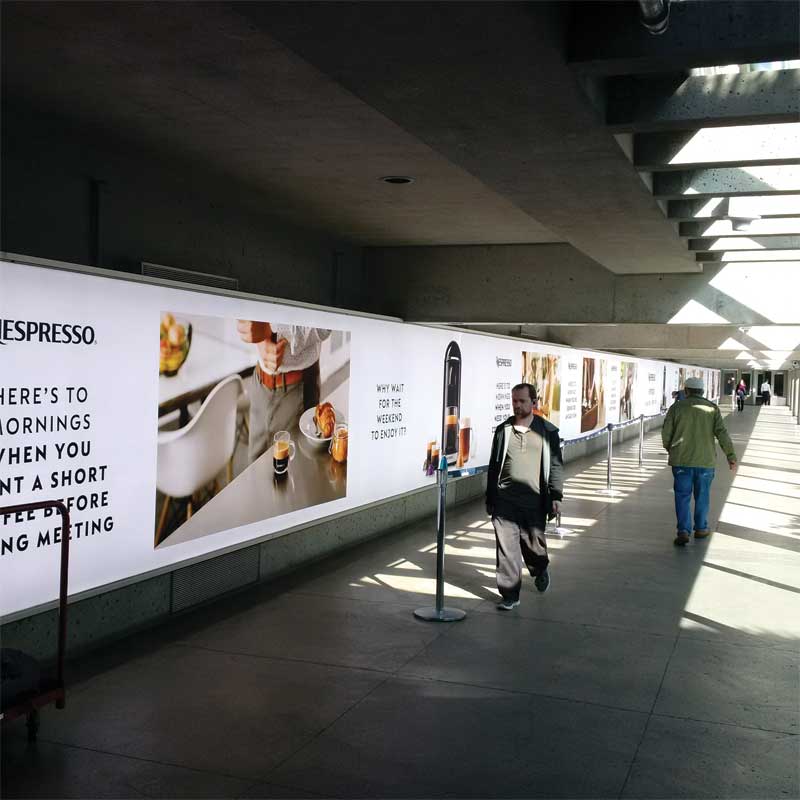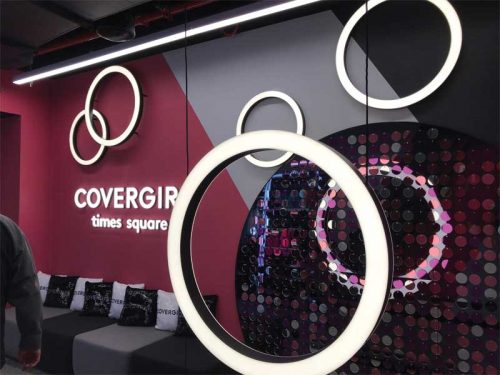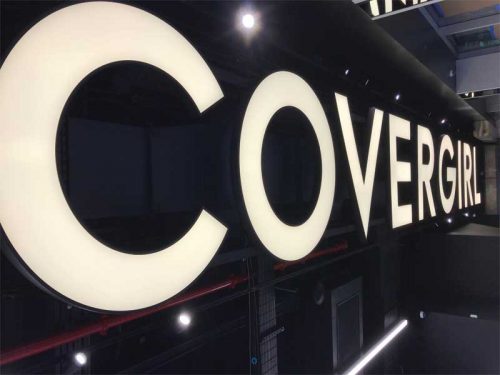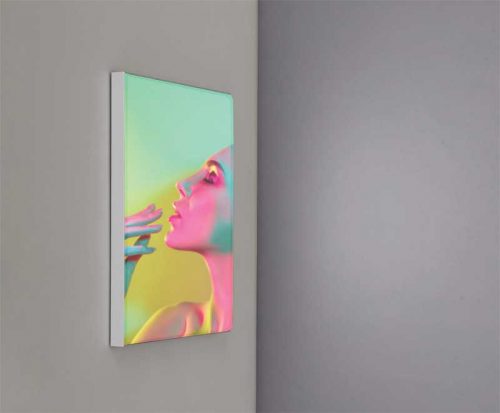Illumination takes centre stage
by | 19 November 2019 10:52 am
By Bill Horst and Rocky Dundas
 [1]
[1]Illuminated signage can provide the dual benefit of maximizing brand exposure with ambient lighting.
Defining signage today is an exercise in limitation. When signage first originated, it was limited to place-based messaging that showcased ideas and concepts that were static and had limited visibility. From non-illuminated signage, the industry progressed rapidly from using spotlights to under-light graphics—in the form of front-lighting to backlighting—which allows illuminated signage to not only display rich colours, but also eliminate the harsh glare and spotting of front-lighting.
The world of signage leapfrogged years ahead with the introduction of backlit illumination and, today, signage has evolved beyond the traditional illuminated format, blurring the lines traditionally seen in sign industry boundaries.
Shedding light on LEDs
Over the years, light-emitting diode (LED) technology has made it possible to do more than simply convey a message. From flashing text and rendering high-contrast colours to rich imagery and animations, LED panels allow businesses and brands to increase customer engagement and brand lift by promoting a company’s message, product, and/or service with greater measurable results. This is possible through installable sensors that track visitor engagement and retention.
These benefits are over and above the advantages of static LED signage, not to mention they are also brighter than other forms of signage, which results in increased visibility, making these signs easier to read from a distance.
The age where signage and lighting were separate design components is a matter of
the past. Business competition has intensified with brands competing for consumer attention by targeting all of their senses. As a result, illuminated signage has become yet another arrow in the quiver of marketers.
A leading light
 [2]
[2]Combining brand elements and illumination through custom lighting provide maximum brand impact.
While today’s advertisers and marketers are aware that adding backlit signage provides a visual pop to brand signage, having an intentional strategy on how to deploy illumination, including lightboxes and fabric backlit graphics, can benefit one’s bottom line. Brands and businesses with an illuminated sign can boost their revenue because it reinforces brand awareness 24-7.
Businesses of every type and size, from local retail stores to professional organizations and to large technological companies, can leverage the added visibility and potential new business as a result of illuminated signage.
The industry is now witnessing the dawn of digital signage in the truest sense of the phrase; signage is now part of a fully integrated environment, which features unified communications. There are an increasing number of brands that realize the impact a cohesive communications strategy can have. What is critical, however, is recognizing the importance of brands integrating all communication touchpoints in a space. That said, digital signage offers businesses the opportunity to develop new and differentiated ways of targeting technology-savvy consumers and improving the customer experience by supporting the customers’ purchasing journey.
In fact, digital signage comes with a unique set of challenges. For starters, several top-tier brands are highly reluctant to share visual space—and sometimes even their messaging—with others. These businesses want their key messages to take the position of primacy. This is not always a good thing as digital signage becomes more prevalent in the proliferation
of ‘digital noise,’ i.e. in a world of constantly cycling messages, nothing is in focus. Further, digital is not a ‘one-size-fits-all’ solution. Essentially, this type of signage might not be the best choice for a brand’s messages regardless of the availability of inventory.

Instead, the world of illuminated signage needs to be optimized for end-user engagement and first-run experiences for an audience. This implies brands need to partner with specialists to understand the marketing options tied to a sign project’s defined strategy and objectives. To do this correctly and effectively, partner consultants must understand how to align brand identity with customer experience through made-to-measure strategic solutions that will communicate the uniqueness of the message.
While illuminated signage has moved from backlighting with fluorescent tubes to integrating LED-light panels into signage, evolution for its own sake is meaningless. Therefore, it is important to be mindful of some of the reasons when and why one would want to use LED lightboxes.
Low profile
One of the key advantages of backlighting is the incredibly low profile it offers in comparison to all other forms of signage. This is crucial for lighting up a sign in tight spaces and for adding illumination to other unique areas.
It is achieved through products such as LED light panels, curtains/lattices, and sheets. There is also the aspect of esthetics, since low profiles have a sleek, modern look because they flatten against the background with
some profiles as low as 15.875 mm (0.625 in.).
Increased visual impact
Brand messages are always competing with a variety of things to capture an audience’s attention (e.g. conversation, social functions, even smartphones). This does not even include advertising noise from competing brands. In the cluttered signage space, backlit lightboxes can be a clear way to stand out from the crowd.
For instance, think about the illumination strategy from the perspective of a busy commuter, walker, or shopper. Would they be more likely to notice a backlit message as opposed to one that is not illuminated? That said, it does not make sense to light up every single message across a space—lighting plays a huge role in what the shopper will focus on—because when everything is important, nothing gets substantial attention. Therefore, brands should integrate light consciously and judiciously to ensure audiences look at the most important branding messages.
Increased product resonance
 [3]
[3]Profiles as low as 15.875 mm (0.625 in.) backlit by light-emitting diode (LED) light panels allow for a modern, clean look that has been adopted by many of today’s brands.
Arguably, the right amount of light in a display can make almost anything pop. The beauty, colour scheme, detail, and quality of brand messages shine through a lot more with correctly backlit signage. The right amount of light and shadow highlights texture and works to solicit emotion from the viewer. Plus, using lightboxes to illuminate one’s message guarantees consistent visibility. This makes it a lot easier for customers to see and to engage with the product.
Using fabric lightboxes instead of staid posters can make a product seem more vibrant and realistic because the lighting environment can be controlled. This is the reason why one would notice a lit-up movie poster on display at a bus stop and remember it more than the exact same poster in a newspaper or on a flyer. If one ever wondered why, in some cases, products do not look quite as good in real life as they do on a hoarding or advertisement it is because of the presentation of the signage, and great lighting is a major component of this.
Improved surrounding illumination

Backlit signage is also incredibly effective in offering more light. Signage providers must consider the light that is provided in the overall environment, and often reconsider their existing commercial lighting fixtures in entirety and end up replacing them with lightboxes.
Often, if done accurately, illuminated signage through lightboxes can solve two problems—highlighting key brand and product messaging, and increasing (or augmenting) available ambience lighting.
One great example of this is retail stores
in malls that use lightboxes as a means of advertising and as a source of illumination. When brands partner with specialized providers they can access customized illumination solutions to fit their needs,
and make the light as bright or as muted as necessary.
Deeper customer connection
Darkness usually has negative connotations, and the converse is also true. Light brings with it feelings of sunshine, happiness, brightness, and general positivity. When someone feels happier, the chances are higher they will want to agree with the message, and take the plunge toward a particular brand and/or experience.
Light brings vitality and energy, a dynamic that non-backlit messages cannot offer. This energy transfers to the customers and audience and, as a result, they will engage, believe, and follow. This ability to activate emotional triggers in consumers is what brands need.
The digital landscape continues to evolve as the consumer experience drives their behaviour. Lighting and proper illumination in any environment will be critical to achieving key objectives and engagement at any level.
Bill Horst is the vice-president marketing for Omnify Lighting. He holds a bachelor of arts in graphic communications management from Ryerson University and has more than 15 years of experience in marketing leadership. He leads all branding, communications, and advertising for Omnify. He can be reached via e-mail at bill@omnifylighting.com
Rocky Dundas is the vice-president sales for Omnify Lighting. He holds an MBA and has been in manufacturing for almost 20 years—from operating his own company to leading sales at a large global company. He is responsible for all sales execution and is a part of a vibrant executive team at Omnify. He can be reached via e-mail at rocky@omnifynow.com.
- [Image]: https://www.signmedia.ca/wp-content/uploads/2019/11/RTH-217.jpg
- [Image]: https://www.signmedia.ca/wp-content/uploads/2019/11/IMG_1588.jpg
- [Image]: https://www.signmedia.ca/wp-content/uploads/2019/11/Engage-Product.jpg
Source URL: https://www.signmedia.ca/illumination-takes-centre-stage/